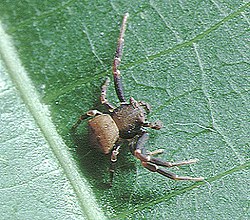Top Qs
Timeline
Chat
Perspective
Thomisus
Genus of spiders From Wikipedia, the free encyclopedia
Remove ads
Thomisus is a genus of crab spiders (family Thomisidae) with around 140 described species.[1] The genus includes species that vary widely in their ecology, with some that are ambush predators that feed on insects visiting flowers. Like several other genera in the family Thomisidae, they are sometimes referred to as flower crab spiders, from their crab-like motion and their way of holding their front legs, reminiscent of a crab spreading its claws as a threat.
Remove ads
Description and behavior
Summarize
Perspective

As with most Thomisidae species, Thomisus exhibit sexual size dimorphism: females are 4 to 10 mm (0.16 to 0.39 in) in length, whereas males are only 2 to 7 mm (0.079 to 0.276 in). Many species are brightly colored, usually matching the color of the flower in which they are waiting in ambush.[2] Not all species are flower-dwelling, but among those that are, at least some species can change their colour over a period of some days to match the flower colour.[3] Studies suggest that bees are inclined to avoid a flower that contains a spider-sized object of a non-matching colour; whether this is specifically a mechanism for avoiding crab spiders, or simply that they are not attracted to flowers whose nectar guides are obscured however, is a more difficult question.[4] The colour changes that such species can achieve are typically in ranges of white, pink, and yellow.

For example, in Thomisus spectabilis, the method of camouflage is similar to the Misumena vatia, though T. spectabilis are visible to their prey, but not their predators. This species of crab spiders is UV reflective while the flower is UV absorbing creating a contrast between the spider and flower through the eyes of the pollinator.[5] The contrast created greatly attracts pollinators such as honeybees. This evolutionary method of camouflage increased the likelihood the crab spiders encountered prey, which in turn effects the fitness of the crab spiders. Due to the increased encounter rate of prey the spiders are able to focus energy on reproduction therefore leading to increased fitness in the spiders. The evolutionary method of camouflage greatly increases the survivability and fitness of crab spiders.
Remove ads
Distribution
The distribution of Thomisus species is almost worldwide, with the notable exception of most of South America.[1] Although Thomisus species can be found almost anywhere on earth, most species occur in the tropics and the warmer regions of the Old World, with fewer species in the region from New Guinea to Australia and the New World. Only Thomisus guadahyrensis is known from South America (in Peru).
Remove ads
Species
Summarize
Perspective
As of September 2025[update], this genus includes 137 species and five subspecies.[1]
Species with articles on Wikipedia:
- Thomisus australis Comellini, 1957 – DR Congo, Burundi, Tanzania, Malawi, Mozambique, South Africa, Lesotho
- Thomisus blandus Karsch, 1880 – Sub-Saharan Africa, Yemen
- Thomisus callidus (Thorell, 1890) – Sri Lanka, Singapore, Indonesia (Sumatra, Nias Is., Java)
- Thomisus citrinellus Simon, 1875 – Mediterranean, Africa, Seychelles, Yemen (mainland, Socotra), Iraq, Iran?
- Thomisus congoensis Comellini, 1957 – Cape Verde, DR Congo, Angola, South Africa, Eswatini
- Thomisus dalmasi Lessert, 1919 – Guinea, Cameroon, DR Congo, Rwanda, Tanzania, Malawi, Mozambique, South Africa
- Thomisus daradioides Simon, 1890 – Africa to India
- Thomisus ghesquierei Lessert, 1943 – DR Congo, South Africa
- Thomisus granulatus Karsch, 1880 – Zambia, Malawi, Namibia, Botswana, South Africa, Eswatini
- Thomisus granulifrons Simon, 1906 – India, Sri Lanka
- Thomisus guadahyrensis Keyserling, 1880 – Peru
- Thomisus kalaharinus Lawrence, 1936 – Sub-Saharan Africa, Yemen
- Thomisus kitamurai Nakatsudi, 1943 – Japan (Ryukyu Is.)
- Thomisus labefactus Karsch, 1881 – Korea, Japan, China, Taiwan, Thailand
- Thomisus machadoi Comellini, 1959 – Cape Verde, Angola, South Africa
- Thomisus marginifrons Schenkel, 1963 – China
- Thomisus natalensis Lawrence, 1942 – Zimbabwe, South Africa
- Thomisus nepenthiphilus Fage, 1930 – Indonesia (Sumatra)
- Thomisus okinawensis Strand, 1907 – Thailand to Japan (Ryukyu Is.), Philippines, Indonesia
- Thomisus onustus Walckenaer, 1805 – Savage Islands, Europe, North Africa, Turkey, Caucasus, Russia (Europe to South Siberia), Israel, Jordan, Iran, Kazakhstan, Central Asia, China, Korea, Japan (type species)
- Thomisus schultzei Simon, 1910 – Namibia, Botswana, South Africa
- Thomisus scrupeus (Simon, 1886) – Sub-Saharan Africa
- Thomisus socotrensis Dippenaar-Schoeman & van Harten, 2007 – Yemen (Socotra)
- Thomisus spectabilis Doleschall, 1859 – India to Australia
- Thomisus spiculosus Pocock, 1901 – Nigeria, DR Congo, Tanzania, Zimbabwe, Mozambique, South Africa
- Thomisus stenningi Pocock, 1900 – Africa, Seychelles, Yemen
- Thomisus zuluanus Lawrence, 1942 – South Africa
- Male T. congoensis
- Male Thomisus kitamurai from Japan
- Female Thomisus kitamurai in Japan
- Female Thomisus okinawensis in Japan
- Female Thomisus labefactus
Remove ads
References
External links
Wikiwand - on
Seamless Wikipedia browsing. On steroids.
Remove ads







